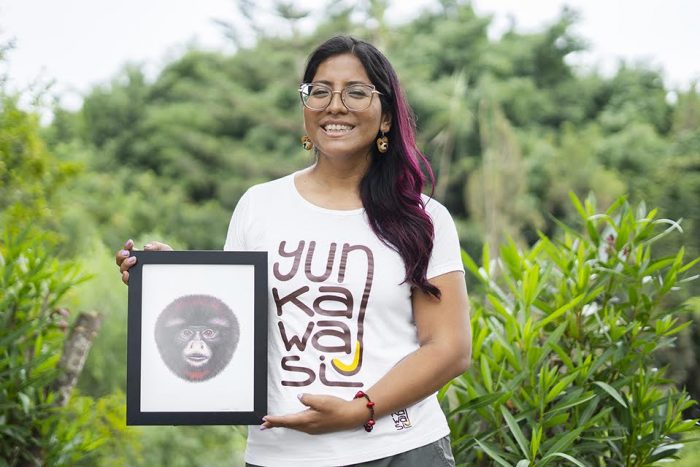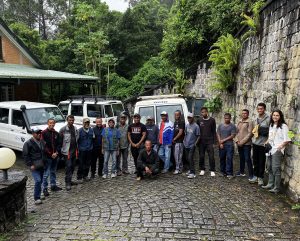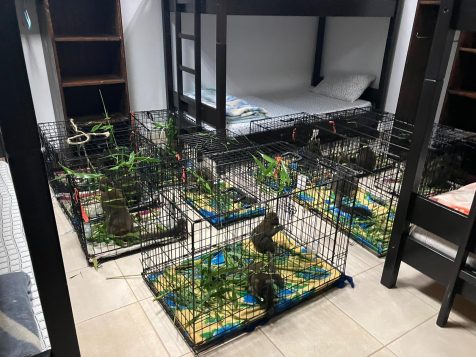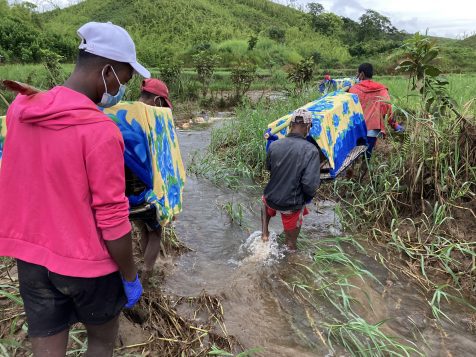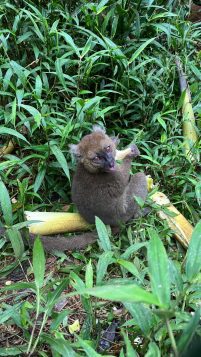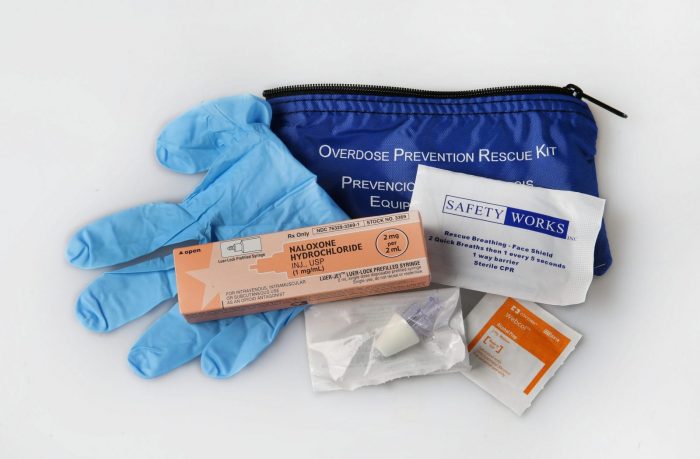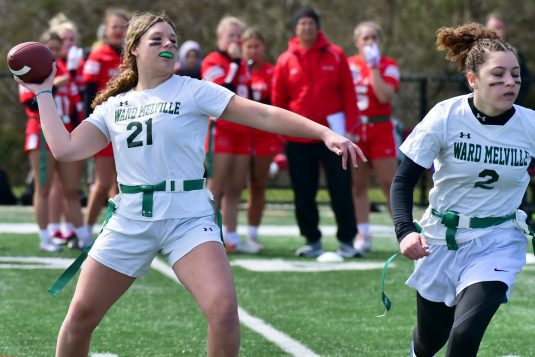Stony Brook University graduate student Fanny M. Cornejo has been named the winner of the newly-created “Emerging Conservationist Award” presented by the Indianapolis Prize. This award recognizes professional wildlife conservationists, biologists and scientists under 40-years of age who are working to make strides in saving animal species from extinction.
Cornejo, a Peruvian primatologist, anthropologist and the executive director of Yunkawasi, an organization that works with Amazonian and Andean communities for the conservation of threatened species through sustainable economic development and protected area management approach, was selected from among 10 finalists. She will receive $50,000 provided by the Kobe Foundation to continue the conservation work of Yunkawasi.
Cornejo is being recognized for her more than 15 years dedicated to the conservation and research of the yellow-tailed woolly monkey, a primate species that only inhabits the montane forests of Peru and is critically endangered due to human unsustainable activities that have generated the loss of over 80% of its population.
Cornejo is a member of the Interdepartmental Doctoral Program in Anthropological Sciences (IDPAS) at Stony Brook University and works in the Pat Wright Lab, where she focuses on the study of primates and big mammals, focusing on diversity, ecological studies as well as conservation activities to protect forests and improve the livelihoods of local and indigenous communities. Cornejo has also conducted research on the black and white ruffed lemurs in Ranomafana National Park in Madagascar. Her graduate mentors are Professors Patricia C. Wright and Liliana Dávalos.
“Fanny lives and breathes conservation. Her energy, her motivation and her success are part of her very being. What a joy to hear that her talents and hard work have been recognized with this inaugural Emerging Conservationist Prize. What an honor for Stony Brook and an honor for Peru!” said Professor Patricia Wright, Distinguished Service Professor and Herrnstein Professor of Conservation Biology.
“Fanny was always a stand-out and it’s fantastic, but not surprising, that her talents and contributions continue to go above and beyond and to be recognized,” said Professor Carl Safina, Holder of the Endowed Chair for Nature and Humanity.
“Fanny is leading the next generation of conservationists to protect nature and inspire people to care for our world. The depth of accomplishments set her apart from the other nominees. I can’t wait to see the impact of her career in conservation,” added Indianapolis Zoological Society President and CEO Dr. Rob Shumaker.
Cornejo will be formally recognized as the 2023 Emerging Conservationist at the Indianapolis Prize Gala presented by Cummins Inc. in downtown Indianapolis on Sept. 30, 2023.
“I am very honored and grateful for this recognition that is not only for me, but also for my entire team, the people we work with, our partners in local communities, governments and our donors. Undoubtedly, being the first winner of the Emerging Conservationist Award and from an organization as important as the Indianapolis Prize is a great recognition for our work in Peru,” said Cornejo.
The Emerging Conservationist finalists were selected through a two-stage selection process, where a review committee evaluated and narrowed the application pool to 10 finalists. Those finalists were then evaluated by a selection committee who chose Cornejo the winner.
The Indianapolis Prize recognizes the world’s leading conservationists whose work provides future generations with replicable and actionable conservation practices. The finalists of the Emerging Conservationists represent the people we can rely on to save species worldwide. Stony Brook University Professors Patricia Wright (2014) and Russ Mittermeier (2018) have both been awarded the Indianapolis Prize.
# # #
About the Indianapolis Prize
The Indianapolis Prize recognizes and rewards conservationists who have achieved major victories in advancing the sustainability of an animal species or group of species. Since 2006, the Indianapolis Prize has given more than $5.6 million in unrestricted cash awards. The Indianapolis Prize is administered by the Indianapolis Zoological Society, Inc.
About Stony Brook University
Stony Brook University — New York’s flagship university and No. 1 public university — is going far beyond the expectations of today’s public universities. It is part of the State University of New York (SUNY) system. With more than 24,000 students, more than 2,800 faculty members, more than 200,000 alumni, a premier academic healthcare system and 18 NCAA Division I athletic programs, Stony Brook is a research-intensive distinguished center of innovation dedicated to addressing the world’s biggest challenges. The university embraces its mission to provide comprehensive undergraduate, graduate and professional education of the highest quality, and is ranked among the top 35 public universities by Forbes and one of the top 80 universities in the nation by the U.S. News & World Report Best Colleges listing. Fostering a commitment to academic research and intellectual endeavors, Stony Brook’s membership in the Association of American Universities (AAU) places it among the top 65 research institutions in North America. The university’s distinguished faculty have earned esteemed awards such as the Nobel Prize, Pulitzer Prize, Indianapolis Prize for animal conservation, Abel Prize and the inaugural Breakthrough Prize in Mathematics. Stony Brook has the responsibility of co-managing Brookhaven National Laboratory for the U.S. Department of Energy — one of only eight universities with a role in running a national laboratory. Providing economic growth for neighboring communities and the wider geographic region, the university totals an impressive $7.23 billion in increased economic output on Long Island. Follow us on Facebook (https://www.facebook.com/
About Yunkawasi
Yunkawasi is a Peruvian non-profit, dedicated to the sustainable development of the territory and the conservation of its biodiversity to achieve the well-being of different human groups. They have more than 16 years of experience working hand in hand with state, civil and private partners for the design and implementation of conservation projects in key ecosystems. Yunkawasi works in various ecosystems, from coastal to Amazonian landscapes, with a focus on conservation and management of protected natural areas, sustainable socioeconomic development, participatory research, and communication and environmental education. They promote an inclusive society that sustainably manages its natural resources, values the benefits they provide, and defend their natural and cultural heritage.

